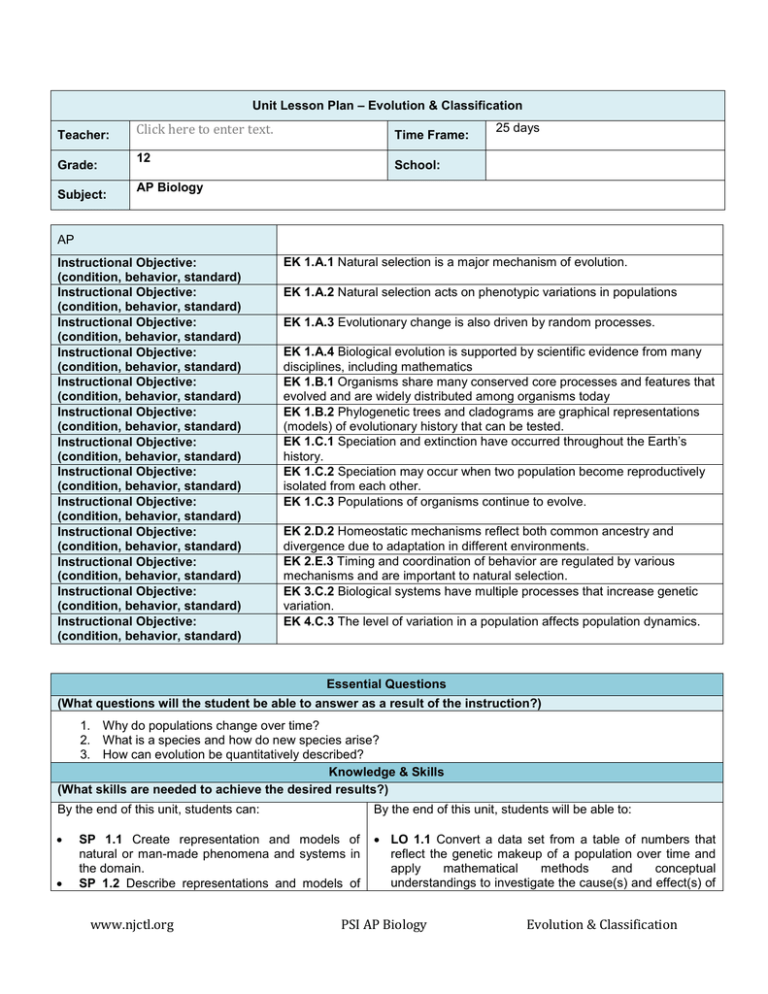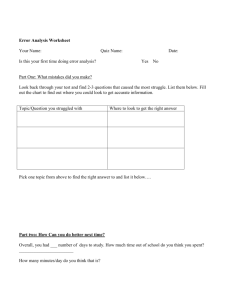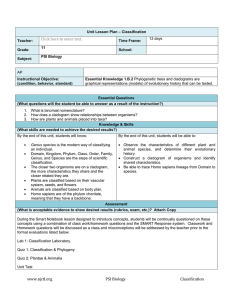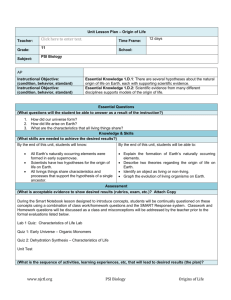Unit Lesson Plan * Atomic Structure
advertisement

Unit Lesson Plan – Evolution & Classification Teacher: Grade: Subject: Click here to enter text. Time Frame: 12 25 days School: AP Biology AP Instructional Objective: (condition, behavior, standard) Instructional Objective: (condition, behavior, standard) Instructional Objective: (condition, behavior, standard) Instructional Objective: (condition, behavior, standard) Instructional Objective: (condition, behavior, standard) Instructional Objective: (condition, behavior, standard) Instructional Objective: (condition, behavior, standard) Instructional Objective: (condition, behavior, standard) Instructional Objective: (condition, behavior, standard) Instructional Objective: (condition, behavior, standard) Instructional Objective: (condition, behavior, standard) Instructional Objective: (condition, behavior, standard) Instructional Objective: (condition, behavior, standard) EK 1.A.1 Natural selection is a major mechanism of evolution. EK 1.A.2 Natural selection acts on phenotypic variations in populations EK 1.A.3 Evolutionary change is also driven by random processes. EK 1.A.4 Biological evolution is supported by scientific evidence from many disciplines, including mathematics EK 1.B.1 Organisms share many conserved core processes and features that evolved and are widely distributed among organisms today EK 1.B.2 Phylogenetic trees and cladograms are graphical representations (models) of evolutionary history that can be tested. EK 1.C.1 Speciation and extinction have occurred throughout the Earth’s history. EK 1.C.2 Speciation may occur when two population become reproductively isolated from each other. EK 1.C.3 Populations of organisms continue to evolve. EK 2.D.2 Homeostatic mechanisms reflect both common ancestry and divergence due to adaptation in different environments. EK 2.E.3 Timing and coordination of behavior are regulated by various mechanisms and are important to natural selection. EK 3.C.2 Biological systems have multiple processes that increase genetic variation. EK 4.C.3 The level of variation in a population affects population dynamics. Essential Questions (What questions will the student be able to answer as a result of the instruction?) 1. Why do populations change over time? 2. What is a species and how do new species arise? 3. How can evolution be quantitatively described? Knowledge & Skills (What skills are needed to achieve the desired results?) By the end of this unit, students can: By the end of this unit, students will be able to: LO 1.1 Convert a data set from a table of numbers that reflect the genetic makeup of a population over time and apply mathematical methods and conceptual understandings to investigate the cause(s) and effect(s) of SP 1.1 Create representation and models of natural or man-made phenomena and systems in the domain. SP 1.2 Describe representations and models of www.njctl.org PSI AP Biology Evolution & Classification natural or man-made phenomena and systems in the domain. SP 1.4 Use representations and models to analyze situations or solve problems qualitatively and quantitatively. SP 1.5 Reexpress key elements of natural phenomena across multiple representations in the domain. SP 2.1 Justify the selection of a mathematical routine to solve problems. SP 2.2 Apply mathematical routines to quantities that explain natural phenomena. SP 2.3 Estimate numerically quantities that describe natural phenomena. SP 3.1 Pose scientific questions. SP 4.1 Justify the selection of the kind of data needed to answer a particular scientific question. SP 4.2 Design a plan for collecting data to answer a particular scientific question. SP 5.1 Analyze data to identify patterns or relationships. SP 5.2 Refine observations and measurements based on data analysis. SP 5.3 Evaluate the evidence provided by data sets in relation to a particular scientific question. SP 6.1 Justify claims with evidence. SP 6.2 Construct explanations of phenomena based on evidence produced through scientific practices. SP 6.4 Make claims and predictions about natural phenomena based on scientific theories and models. SP 7.1 Connect phenomena and models across spatial and temporal scales. SP 7.2 Connect concepts in and across domain(s) to generalize or extrapolate in and/or across enduring understandings and/or big ideas. www.njctl.org this change. (SP 1.5, 2.3) LO 1.2 Evaluate evidence provided by data to qualitatively and quantitatively investigate the role of natural selection in evolution. (SP 2.2, 5.3) LO 1.3 Apply mathematical methods to data from a real or simulated population to predict what will happen to the population in the future. (SP 2.2) LO 1.4 Evaluate data-based evidence that describes evolutionary changes in the genetic makeup of a population over time. (SP 5.3) LO 1.5 Connect evolutionary changes in a population over time to a change in the environment. (SP 7.1) LO 1.6 Use data from mathematical models based on the Hardy-Weinberg equilibrium to analyze genetic drift and effect of selection in the evolution of specific populations. (SP 1.4, 2.1) LO 1.7 Justify from mathematical models based on the Hardy-Weinberg equilibrium to analyze genetic drift and the effect on selection in evolution of specific populations. (SP 2.1) LO 1.8 Make predictions about the effects of genetic drift, migration and artificial selection on the genetic makeup of a population. (SP 6.4) LO 1.9 Evaluate evidence provided by data from many scientific disciplines that support biological evolution. (SP 5.3) LO 1.10 Refine evidence based on data from many scientific disciplines that support biological evolution. (SP 5.2) LO 1.11 Design a plan to answer scientific questions regarding how organisms have changed over time using information from morphology, biochemistry and geology. (SP 4.2) LO 1.12 Connect scientific evidence from many scientific disciplines to support the modern concept of evolution. (SP 7.1) LO 1.13 Construct and/or justify mathematical models, diagrams or simulation that represent processes of biological evolution. (SP 1.1, 2.1) LO 1.14 Pose scientific questions that correctly identify essential properties of shared, core life processes that provide insights into the history of life on Earth. (SP 3.1) LO 1.15 Describe specific examples of conserved core biological processes and features shared by all domains or within one domain of life, and how these shared, conserved core processes and features support the concept of common ancestry for all organisms. (SP 7.2) LO 1.16 Justify the scientific claim that organisms share many conserved core processes and features that evolved and are widely distributed among organisms today. (SP 6.1) LO 1.17 Pose scientific questions about a group of organisms whose relatedness is described by a phylogenetic tree or cladogram in order to (1) identify shared characteristics, (2) make inferences about the PSI AP Biology Evolution & Classification evolutionary history of the group, (s) identify the character data that could extend or improve the phylogenetic tree. (SP 3.1) LO 1.18 Evaluate evidence provided by a data set in conjunction with a phylogenetic tree or a simple cladogram to determine evolutionary history and speciation. (SP 5.3) LO 1.19 Create a phylogenetic tree or simple cladogram that correctly represent evolutionary history and speciation from a provided data set. (SP 1.1) LO 1.20 Analyze data related to questions of speciation and extinction throughout Earth’s history. (SP 5.1) LO 1.21 Design a plan for collecting data to investigate the scientific claim that speciation and extinction have occurred throughout Earth’s history. (SP 4.2) LO 1.22 Use data from a real or simulated population(s), based on graph or models of types of selection, to predict what will happen to the population in the future. (SP 6.4) LO 1.23 Justify the selection of data that address questions related to reproductive isolation and speciation. (SP 4.1) LO 1.24 Describe speciation in an isolated population and connect it change in gene frequency, change in environment, natural selection and/or genetic drift. (SP 7.2) LO 1.25 Describe a model that represent evolution within a population. (SP 1.2) LO 1.26 Evaluate given data sets that illustrate evolution as an ongoing process. (SP 5.3) LO 2.26 Analyze data to identify phylogenetic patterns or relationships, showing that homeostatic mechanisms reflect both continuity due to common ancestry and change due to evolution in different environments. (SP 5.1) LO 2.27 Connect differences in environment with the evolution of homeostatic mechanisms. (SP 7.1) LO 2.38 Analyze data to support the claim that responses to information and communication of information affect natural selection. (SP 5.1) LO 3.28 Construct an explanation of multiple processes that increase variation within a population. (SP 6.2) LO 4.25 Use evidence to justify a claim that a variety of phenotypic responses to a single environmental factor can result from different genotypes with the population. (SP 6.1) LO 4.26 Use theories and models to make scientific claims and/or predictions about the effects of variation within populations on survival and fitness. (SP 6.4) Assessment (What is acceptable evidence to show desired results (rubrics, exam, etc.)? Attach Copy www.njctl.org PSI AP Biology Evolution & Classification During the Smart Notebook lesson designed to introduce concepts, students will be continually questioned on these concepts using a combination of class work/homework questions and the SMART Response system. Classwork and Homework questions will be discussed as a class and misconceptions will be addressed by the teacher prior to the formal evaluations listed below. Formative Evaluations: Summative Evaluations: Artificial Selection Lab (continued in this unit) Darwin & Evidence for Evolution Quiz Lab #2: Mathematical Modeling: Hardy-Weinberg Lab #2 Quiz Lab #10: Energy Dynamics (begun in this unit, assessed Natural Selection & Population Genetics Quiz in Ecology unit) Macroevolution & Reproductive Isolation Quiz Lab #3: Comparing DNA Sequences to Understand Lab #3 Quiz Evolutionary Relationship with BLAST Lab #1 Quiz Unit Test (What is the sequence of activities, learning experiences, etc, that will lead to desired results (the plan)? Topic Classwork Homework 1 Darwin Inferences SMART Notebook Slides 423 #12-14 2 Darwin’s Journey SMART Notebook Slides 24-47; Questions #1-5 #15-17 3 Evidence for Evolution SMART Notebook Slides 48-67; Questions #6-7 #18-19 4 Evidence for Evolution Lab 1: Begin Drying Seeds SMART Notebook Slides 68-81; Questions #9-11 #20-21 5 Natural Selection Quiz 1: Darwin & Evidence SMART Notebook Slides 82-100; Questions #22-27 #28-32 6 Population Genetics SMART Notebook Slides 101-123; Questions #33-40 #41-47; Lab #2 Pre-Lab 7 Mathematical Modeling Lab Lab #2: Steps 1-3 8 (lab) Mathematical Modeling Lab Lab #2: Step 4-7 9 Artificial Selection Lab Lab #1: Planting 2nd generation Day www.njctl.org PSI AP Biology Complete Analysis Evolution & Classification 10 Mathematical Modeling Lab Lab #2: Independent Inquiry 11 Mathematical Modeling Lab Lab #2: Independent Inquiry Analysis and Reporting 12 Hardy-Weinberg Review 13 Macroevolution 14 Reproductive Isolation 15 Phylogenetics 16 Phylogenetics SMART Notebook Slides 191-222; Questions #63-66 #67-70; Lab #10 Pre-lab 17 Energy Dynamics Lab Lab #10: Getting Started & Step 1 Experimental Design 18 Energy Dynamics Lab Lab #10: Step 2 & Planting Lab #3 Pre-lab 19 (lab) BLAST Lab Lab #3: Guided Practice 20 BLAST Lab Lab #3: Independent Inquiry Analysis 21 Artificial Selection Lab Lab #3 Quiz Lab #1: Steps 12-13 MC/FR 22 Artificial Selection Lab Lab #1: Step 14 & Discussion Review for Lab Quiz 23 Energy Dynamics Lab Lab #1 Quiz Lab #10: Mass young plants; start new seeds for Independent Inquiry MC/FR 24 Review MC/FR Study 25 Test Unit Test www.njctl.org Lab #2 Quiz SMART Notebook Slides 124-145 Quiz 2: Natural Selection & Pop. Genetics SMART Notebook Slides 146-169; Questions #48-50 SMART Notebook Slides 170-190 ; Questions #5154 Quiz 3: Macroevolution & Isolation Non-Lab Activity: Dichotomous Key PSI AP Biology Study for Quiz #55-57 #58-62 Complete activity Evolution & Classification





